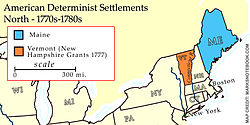
Back Republiek van Vermont Afrikaans جمهورية فيرمونت Arabic Vermont Respublikası Azerbaijani ورمونت جومهوریتی AZB República de Vermont Catalan Vermontská republika Czech Vermont Republic German República de Vermont Spanish جمهوری ورمانت Persian Vermontin tasavalta Finnish
State of Vermont | |||||||||||||||
|---|---|---|---|---|---|---|---|---|---|---|---|---|---|---|---|
| 1777–1791 | |||||||||||||||
| Motto: Freedom and Unity (on Great Seal) Stella quarta decima (English: the fourteenth star; on Vermont coinage) | |||||||||||||||
 Location of the Vermont Republic in 1777 (modern state boundaries shown). | |||||||||||||||
| Capital |
| ||||||||||||||
| Common languages | |||||||||||||||
| Government | Republic | ||||||||||||||
| Governor | |||||||||||||||
• 1778–1789 | Thomas Chittenden | ||||||||||||||
• 1789–1790 | Moses Robinson | ||||||||||||||
• 1790–1791 | Thomas Chittenden | ||||||||||||||
| Legislature | House of Representatives of the Freemen of Vermont | ||||||||||||||
| Historical era | Early modern period | ||||||||||||||
• Independence | January 15, 1777 | ||||||||||||||
• Admission to the Union with the United States | March 4, 1791 | ||||||||||||||
| Currency | Vermont copper | ||||||||||||||
| |||||||||||||||
| Today part of | |||||||||||||||
The Vermont Republic officially known at the time as the State of Vermont, was an independent state in New England that existed from January 15, 1777, to March 4, 1791.[1] The state was founded in January 1777, when delegates from 28 towns met and declared independence from the jurisdictions and land claims of the British colonies of Quebec, New Hampshire, and New York. The republic remained in existence for the next fourteen years, albeit without diplomatic recognition from any foreign power. On March 4, 1791, it was admitted into the United States as the State of Vermont, with the constitution and laws of the independent state continuing in effect after admission.[2]
The delegates forbade adult slavery within their republic, although the Vermont constitution continued to make allowances for the enslavement of men under the age of 21 and women under the age of 18. Many Vermonters took part in the American Revolution on the side of the Revolution, but the Continental Congress did not recognize the independence of Vermont (then also known as the New Hampshire Grants) due to objections from New York, which had conflicting property claims.[3][4] In a response to this, members representing Vermont conducted negotiations to join the Province of Quebec, which were accepted by the British, who offered generous terms for the republic's reunion. When the British surrendered at the Siege of Yorktown in 1781, however, American independence became apparent. Vermont, later bordered on three sides by U.S. territory, ended negotiations with Britain and instead negotiated terms to become part of the United States.[5]
Many of its citizens favored political union with the United States rather than full independence. While the Continental Congress did not allow a seat for Vermont, Vermont engaged William Samuel Johnson, representing Connecticut, to promote its interests.[6] In 1785 the Vermont General Assembly granted Johnson title to the former King's College Tract as a form of compensation for representing Vermont.[7]
- ^ Van DeWater, Frederic F. (1974) [1941]. The Reluctant Republic, Vermont 1724–1791. The Countryman Press. pp. 195, 218–219. ISBN 978-0-914378-02-0.
- ^ Van de Water, p. 337
- ^ "Journals of the Continental Congress --MONDAY, JUNE 30, 1777". memory.loc.gov.
- ^ Onuf, Peter S. (1981). "State-Making in Revolutionary America: Independent Vermont as a Case Study". Journal of American History. 67 (4): 806–7. doi:10.2307/1888050. JSTOR 1888050.
- ^ Bemis, S. F. (1916). "Relations between the Vermont Separatists and Great Britain, 1789–1791". American Historical Review. 21 (3): 547–560. doi:10.1086/ahr/21.3.547.
- ^ Swift, Esther M. (1977). Vermont Place-Names, Footprints in History. The Stephen Greene Press. pp. 282–283. ISBN 978-0-8289-0291-5.
- ^ Swift, Esther M. (1977). Vermont Place-Names, Footprints in History. The Stephen Greene Press. pp. 580, 587–588. ISBN 978-0-8289-0291-5.
